The first time I experienced an orchestra I was 7. A year earlier, a roving teacher visited my class carrying a bag filled with plastic recorders. She gave us a simple challenge: “I’ll be back in a week to see how many of you can play this song without squeaking!” As promised, she returned one week later, and miraculously I made the cut. My reward was to be enrolled at the Newham Academy of Music in London. A week later, another teacher handed me a tiny violin and said, “If you can play the song I just taught you by next week without squeaking, you can stay.” I noticed a trend—squeaking on any instrument was bad. A year later, I was on stage at the Royal Albert Hall with about 50 other kids. Our orchestra was called Da Capo, which means “from the beginning.”
Over the next four decades as a composer, I continued to have close encounters with orchestras: London Symphony Orchestra at 19, Buffalo Philharmonic Orchestra at 40, and Detroit Symphony Orchestra at 45. It became apparent to me, even at 19, how exceedingly difficult it was for people who looked like me to become involved in the orchestral world—a world created around an enduring European tradition which rarely took us into account. This was true of all the various institutions, and even nations, that populated the long road travelled towards becoming an orchestral musician or composer. And to a large extent, this is still true today.
Due to my early experiences in Da Capo, or my fascination with the idea that 50 to 80 people could all work together in sync to create music, I had always dreamt of an orchestra that could be representative of the actual residents—and sounds—of the city where it resided.
Philadelphia’s Public Orchestra offers an alternative to traditional classical ensembles, with room for all instruments and backgrounds.
The Public Orchestra, one module of Rehearsing Philadelphia, an expansive musical project/meta score created by American artist and composer Ari Benjamin Meyers and funded and produced by a quorum of local institutions, had that same goal in mind. Thus, when they offered me the musical director gig it was an easy yes! See more about this massive project and Ari’s manifesto for it here.
The Public Orchestra of Philly is a complete reimagining of what an orchestra could, or should, be. It began with Ari’s question, “How can we be together?” We considered the vast gamut of musical communities within Philadelphia—jazz, gospel, soul, hip-hop, classical, folk, Indian, Brazilian, Mexican, Cuban, Philipino, Klezmer, Arabic, Korean, West African, and many others—and pondered how these could all be represented and coexist within a 50-piece ensemble. Just two of the orchestra’s members are Tchin, who plays the Native American nose flute, and Matthew Law, who plays the turntables. See our stage plot below for a complete listing of the instruments chosen.
Notation is a useful tool, especially within orchestras, which are notoriously expensive to rehearse. But when considering the musical traditions that exist outside the realm of Western notation—most—it can become a barrier. Not requiring our participants to read music allowed many more musical communities to be included. Repertoire was another area we considered. We knew that the orchestra should perform new works written specifically for it, which would require commissions.

We asked, “What is a composer?” The traditional conventions governing orchestral composition—the typical “top down” hierarchy involving a conductor and score, sections and parts, first and second chairs, and even the idea of pre-composed music—meant that the pool of people who could compose for orchestras was quite limited. However, our composer pool grew exponentially once we reconsidered those. We commissioned five wildly different composers: Ann Carlson (choreographer), Ursula Rucker (performance poet), Xenia Rubinos (Latinx electronic music artist), Ari Benjamin Meyers (the project’s architect), and Marshall Allen of the Sun Ra Arkestra (97-year-old free jazz luminary).
Butch Morris, Anthony Braxton, and others explored an entire system of conducting with the goal of spontaneous composition in mind. Butch’s system, with its extensive array of gestures, formed the basis of how I chose to interact with the orchestra as its musical director/conductor. With this approach, the orchestra and I were able to create complex improvisations that sound pre-composed, but which actually required zero reading. We asked our composers to create works which could be taught by ear and played from memory. Using these two methods, we were all able to create a dynamic 90-minute show representing Philadelphia.
The result? The three Public Orchestra performances at Cherry Street Pier included some of Philadelphia’s most diverse and genuinely engaged audiences. The compositions performed spanned hip-hop and avant dance, serialism and free jazz, vocal chants and soaring cadenzas, and many other unique mixes unexpected at an orchestra performance. Much like the orchestra itself, these shows didn’t speak to any one traditional or culture. They were soul stirring events, which brought people from all walks of life to experience each other, play and create great art together.
To be continued!
From Your Site Articles
Related Articles Around the Web









